Dear Friends, Near and Far,
Greetings to you all from Nagi Gonpa, the nunnery and hermitage nestled in the serene Shivapuri Mountain of the Kathmandu Valley. Presently at Nagi, we have Chokyi Nyima Rinpoche, Tsikey Chokling Rinpoche and Yangsi Tulku Urgyen Rinpoche all engaged in the yearly nine day Ngakso Drupchen. Ngakso or Ngak kyi Sojong is a Vajrayana practice of mending and purification. Tulku Urgyen Rinpoche explained that in the Ngak kyi Sojong, we are mending and restoring the commitments of the vows of the individual liberation in accordance with the Hinayana system, the bodhisattva trainings, in accordance with the Mahayana system, and the samaya commitments, in accordance with the Vajrayana system. And in terms of the purification, Read the rest of this entry/อ่านรายละเอียด »
Photos from HH. Phakchok Rinpoche visit to Bangkok in January 2011
ภาพถ่ายจากงานบรรยายต่างๆในกรุงเทพฯ ของสมเด็จพักชก ริมโปเช ในเดือน มกราคม 2554
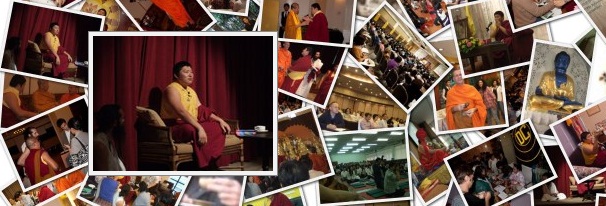
Dear Friends,
I hope you’ve all been happy and healthy. This being the first Guru Rinpoche Day message of the year 2011, and to start off the year auspiciously, I would like to share with you the Five Unshakeable Fortresses that is key for all dharma practitioners.
The Five Unshakeable Fortresses:
The five fortresses are extremely important for all dharma practitioners. If you don’t have these five, then actually it means that you are not doing quite so well…
1. Gaining Certainty in the View
Many of us when practicing the dharma are so busy doing things, physically, in the dharma world. Such as offering butter lamps, doing circumambulations, reading many texts, doing a lot of different daily practices, and while doing so, our precious time runs out. Though the time is not wasted on doing something unnecessary, but while engaging in doing these “dharmic activity”, we sometimes loose the focus or the point of doing it all and therefore completely lack in gaining certainty in and reconfirming, the view.
The earlier masters all said this so many times. Tilopa said that when you’ve lost the correct view your practice is gone. You may be very devoted and have a lot of faith, but you’re not going to have a correct practice because you lack the correct view. So the first most important thing is having certainty in the view.
How to get that?
Reinvestigating your emotions, your ego, ‘I’, your judgmental mind.
Why does my judgmental mind work so well?
Because I’m not reconfirming my understanding of egolessness.
Why are my negative emotions working so well?
Because, I’m not reconfirming my understanding of egolessness.
Why am I so moody?
Because, you forgot to reconfirm egolessness, selflessness. Really.
Why can we not have compassion that is free from judgment?
Because we lack an understanding of egolessness.
Why can we not have trust in emptiness?
Because we cannot gain trust in egolessness. That’s why.
Why when you practice the deity, do you see the deity as truly existent?
Because you have no understanding of egolessness.
So whatever practice you do, spend at least some time to re-investigate your emotions, your ‘I’, your judgment, your ego, your clinging, your anxiety. That is gaining certainty in the view and that means you are making an unshakeable fortress of the view.
2. Being Undistracted in Meditation
We talk about meditation all the time. This meditation, that meditation. Shamatha, Vipashyana, Mahamudra, the Development Stage, Mind Training, the Middle Way, the Great Perfection! But whatever meditation you do, we talk about five stages: movement, attainment, familiarization, stability, and perfection. The first is like a waterfall, the second a river gorge, the third a calm river, the fourth an ocean without waves, and the fifth like an unshakeable mountain. These experiences are actually measurements.
Measurements of what? Measurements of distraction. Having the most distraction is the first experience, the waterfall, and having a little less distraction is the river gorge. Again, when you’re a little calmer and when the rough distractions are gone, but subtle distractions are still there, it is the calm river. If you have less subtle distraction, that’s the ocean without waves, and even less, the mountain. So when you do meditation, you should know that the unshakeable fortress of meditation is non-distraction.
3. Conduct
Dharma practitioners should have a good conduct. Conduct is very important and on a simple level, we can say not doing harmful things to oneself and others and doing things to benefit others and oneself. Basically not harming others physically, verbally, or mentally. Bottom line; always being mindful of your conduct.
In the Mirror of Mindfulness, my master, Nyoshul Khen Rinpoche said, “When you don’t have mindfulness, you are a shit pot. When you don’t have any mindfulness, you are a dead body.”
To clarify Rinpoche’s quote, no matter how much you clean yourself, with brushing or washing, if you are not mindful of your conduct, you are always carrying that shit around and therefore you are always going to smell of shit no matter what. It is all the works of this “deluded mind” that we grasp to “what is” to “what is not” and therefore see unclean as clean, to what is impermanent as permanent, to what is selfless as having self, and to pain as pleasure.
So how can we work with this delusion?
By practicing mindfulness.
How to practice mindfulness in conduct?
By reminding. Not watching, but reminding yourself in whatever you do, to not forget what the buddhadharma really is. When you walk around the Buddha’s stupa in Boudhanath, remind yourself that you are walking around it to tame your mind. Remind yourself, “I am studying for enlightenment, to tame my mind.” Whatever you do, you need to remember the main core of the Buddha’s teaching; that is real conduct, how to keep conduct well. So please take it to heart.
I remember our late principal, Khenpo Kunga Wangchuk constantly telling the graduating class, “If you cannot help the dharma, at least don’t harm the dharma. Keep that in mind. Don’t think that you are acting alone. Individually, you are a pillar of the dharma. Individually, you represent the dharma. And therefore individually, your conduct will have a consequence on the dharma.” So mindfulness in conduct is the key.
4. Clearing Away Obstacles
When you start practicing the dharma, you’re going to face obstacles. I asked Nyoshul Khen Rinpoche one day, “Rinpoche, why is it like this? Whenever I want to do some kind of practice, I have an obstacle. Whenever I don’t want to do practice, I have no obstacle. Why is it like this?” For example, whenever I start meditating, all my worries come up and whenever I meditate my answers to those worries also come. Whenever I start thinking, the answers don’t come!
When you have difficulties in meditation, what is the best way to remove them? You can check many Mahasiddhas’ methods, many different masters’ texts, but all the time they say the same thing. What? Devotion. All the time they say this, and we have difficulty with that. It’s difficult for us to practice devotion, but if you look in any text, by Tilopa, Maitripa and so on, they all say, “Visualize the guru above your head surrounded by the lineage masters, and supplicate to them, receive the four empowerments, and think that your obstacles have all been removed.” In all the meditation manuals it teaches the same thing. So devotion is key.
What is devotion like? It has three qualities: certainty in the dharma, pure perception, and remembering the kindness. Parents’ kindness is extremely important: your mother keeps you for nine months in her womb, gives birth to you, feeds and clothes you, and helps you grow up. Our parent’s kindness is very important. But who teaches you to be independent? Who teaches you to actually be free from your emotions and suffering? Who guides you towards the truth so that you can actually be free? It’s the guru. That is remembering the kindness. Then we also have certainty and pure perception. With these three qualities, you can develop devotion easily.
5. Enhancement
How to enhance or improve your practice? First of all, why actually can we not improve our practice that much? It is because we have so many things to hold on to, and to get hooked with. For someone like me, we have monasteries, monks, projects, and all the planning that goes along with it. For some practitioners, it’s deities and accumulating merit, and for some, families, cars, your favorite brand, etc. These days, I’ve started liking the brand Burberry. Before I didn’t even know what it was, but now I really like it, and it’s very expensive. I love Mont Blanc too. There’s nothing there actually, but I like it. When people look at you, if you’re wearing a Mont Blanc pen, you’re okay, but if you’re wearing a lousy pen then you are judged to be worth just that. So all the time, we are judging and being judged. And now you feel you need to keep up to that. You start holding onto things, getting attached, worrying, and that’s why our meditation practice cannot improve well.
That’s why many great masters of the past practiced pongdag. For example, I heard that when Dilgo Khyentse Rinpoche reached Bodhgaya in India, a long time ago, he decided to give everything up through pongdag. Pongdag literally means to give up or to abandon. Khenpo Ngakchung did this three times. I also heard a story about Trulshik Rinpoche. For old masters, old statues are extremely important for them. You can give them a kilo of gold and they don’t care at all, but they really treasure their old statues. When Trulshik Rinpoche was receiving empowerments from Dilgo Khyentse Rinpoche, he cleaned out his entire altar by offering all of his precious statues to him.
In the past, I would count everyday how many things I owned, how many things I had to give up. I would count each thing on my fingers. We need to learn how to do this, how to practice pongdag mentally, to give up everything, and offer it as a mandala offering.
Many masters say that when you go to retreat, you need to cut your worldly perceptions and then your practice will improve very fast, but if you bring worldly concerns with you then your practice won’t improve as much. So I try to tell myself everyday when doing meditation, first of all, to give up my projects, my house, everything. This is what I do first for five minutes. After that I give rise to devotion and supplicate and then I meditate. If you do that, your meditation will improve so fast that you will be amazed.
So these are called the five unchanging fortresses of the dharma practitioner.
Certainty in the view
Non-distraction in meditation
Mindfulness in conduct
Dispelling obstacles with devotion
Enhancing through pongdag
Don’t forget these five, and try to improve them. When you can improve these five things in yourself, your practice is going to improve. You can check a hundred texts, meet a thousand masters, but they are not going to say anything more than this. When practicing, too much information isn’t that helpful, but one pithy piece of advice, a key, can help us change a lot!
Sarva Mangalam,
Phakchok Rinpoche
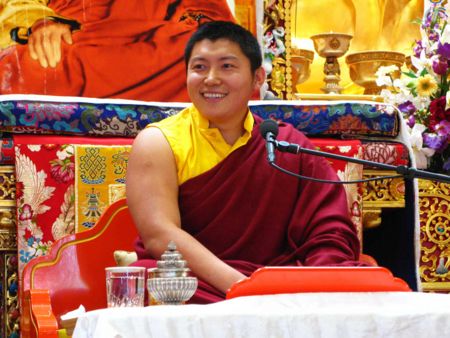
เป็นผู้สืบทอดการปฏิบัติสาย ชกจูร์ ลิงปะ (Chok Gyur Lingpa Lineage) แห่งนิกายญิงมา-ปะ (Nyingma School of Early Translation) ซึ่งเป็นนิกายโบราณของพุทธศาสนาวัชรยาน ท่านสืบเชื้อสายมาจาก ชกลิง ริมโปเช (His Eminence Chokling Rinpoche) และ ดีเชน ปาลดรอน (Dechen Paldron) เกิดเมื่อปี พ.ศ. 2525 ที่ประเทศเนปาล ท่านเดินทางเผยแผ่พุทธศาสนาในหลายๆประเทศ ซึ่งเอกลักษณ์ในการถ่ายทอดคำสอนของท่านมีลักษณะตรงไปตรงมา และเข้าใจง่าย
ตำแหน่งปัจจุบัน
• ผู้ครองบัลลังก์สายการปฏิบัติ “ รีโวเช ตักลุง การ์จู (Riwoche Taklung Kagyu Lineage) ” แห่งวัดรีโวเช (Riwoche Monastery)
• วัชราจารย์ของวัดกาญิง เชดรุป (Vajra Master: Ka-Nying Shedrub Ling Monastery) ที่ โพธนาถ (Boudhanath) เมืองกาฐมัณฑุ ประเทศเนปาล
• เจ้าอาวาสวัดโดงัก ญีดา ซุงเทรล เชดรุป รัลตรี (Abbot of Do-ngak Nyida Zungdrel Shedrab Raldri Ling Monastery) ประเทศเนปาล
• เจ้าอาวาสวัดปัล การ์จู เชดรุป ตาชี ทาเกย์ พุนสก (Abbot of Pal Kagyu Shedrub Tashi Dhargye Phuntsok Ling Monastery) ประเทศเนปาล
• ประธานของ รังจุง ยีชี เช็นเปน (President of Rangjung Yeshe Shenpen) อันเป็นองค์กรการกุศล เพื่อช่วยเหลือผู้ยากไร้ และผู้ด้อยโอกาสด้านการศึกษาและสาธารณสุขในประเทศเนปาล
• ศาสตราจารย์วิชาพุทธปรัชญา (Professor of Buddhist Philosophy) ที่สถาบันรัง จุง ยีชี (Rangjung Yeshe Institute Shedra) ศูนย์พุทธศาสนศึกษา (Center of Buddhist Studies) มหาวิทยาลัยกาฐมัณฑุ (Kathmandu University) ประเทศเนปาล ท่านสอนพุทธปรัชญาทั่วไปโดยเฉพาะอย่างยิ่งปรัชญามาธยมิกะ (The Middle Way)
การศึกษา
• ได้รับวุฒิทางการศึกษาระดับ “เคนโป (mKhan po)” ซึ่งเทียบเท่าปริญญาเอก (Ph.D.) ทางศาสนาวิทยา (Doctor of Divinity) จากองค์สมเด็จดาไลลามะที่ 14 (His Holiness 14th Dalai Lama) และจาก จงซาร์ เคียนเซ ริมโปเช (H.E. Dzongzar Khyentse Rinpoche)
• จบการศึกษาหลักสูตรพุทธปรัชญาที่สถาบันการศึกษาพุทธศาสนาชั้นสูงจงซาร์ (Dzongsar Institute of Advanced Buddhist Studies) ที่ เมืองบีร์ (Bir) มณฑลหิมาจัล (Himachal Pradesh) ประเทศอินเดีย (India) ซึ่งเน้นการศึกษาด้านคำสอนของ สายสาเกียปะ กับ เคนเชน กุงกา วังชุก ริมโปเช (Khenchen Kunga Wangchuk Rinpoche) และ จงซาร์ เตียนเซ ริมโปเช (H.E. Dzongsar Khyentse Rinpoche) ซึ่งท่านใช้เวลาในการศึกษาเพียง 7 ปี จากเวลาปกติ 9 ปี
งานเผยแผ่
• วิทยากรรับเชิญบรรยายธรรม ณ ศูนย์ปฏิบัติธรรมหลายแห่งทั่วโลก อาทิ ประเทศเดนมาร์ก ประเทศเยอรมันนี ประเทศออสเตรีย ประเทศสวิสเซอร์แลนด์ ประเทศเบลเยี่ยม ประเทศสหรัฐอเมริกา ประเทศแคนาดา ประเทศอเมริกา ประเทศอเมริกาใต้ และ ประเทศแถบเอเซียตะวันออกเฉียงใต้ ฯลฯ
• ผู้ก่อตั้งศูนย์ปฏิบัติธรรมหลายแห่งในประเทศมาเลเซีย
Kyabgon Phakchok Rinpoche is a lineage holder of the Profound Treasures of Chokgyur Lingpa from the Nyingma School of Early Translation and throne-holder of Riwoche Taklung Kagyu Lineage.
Currently duties
• Vajra Master of Ka-Nying Shedrub Ling Monastery (in Boudhanath Kathmandu, Nepal)
• Abbot of Pal Do-Ngak Nyida Zungdrel Mindrol Norbuling Monastery (Nepal)
• Abbot of Pal Kagyu Shedrub Tashi Dhargye Phuntsok Ling Monastery (Nepal)
• President of Rangjung Yeshe Shenpen Nepal, a volunteer-based, non-profi t organization that serves the poor and disadvantaged in Nepal
• Professor of Buddhist Philosophy, Rangjung Yeshe Institute Shedra, Center of Buddhist Studies, Kathmandu University, where he teaches general Buddhist philosophy with emphasis on the Middle Way
Education
Phakchok Rinpoche received the Khenpo title (similar to a Doctor of Divinity) from H.H. 14th Dalai Lama and H.E. Dzongsar Khyentse Rinpoche. He completed in seven years the traditional nine-year curriculum of Buddhist philosophy at the Dzongsar Institute of Advanced Buddhist Studies, Bir, Himachal Pradesh, India, where he specialized in studies of the Sakya School of Tibetan Buddhism under the guidance of Khenchen Kunga Wangchuk Rinpoche and H.E. Dzongsar Khyentse Rinpoche.
An enthusiastic and vibrant young teacher, Phakchok Rinpoche’s lectures are direct and easily understood. Since 1999 he has served as Professor of Buddhist Philosophy at the Rangjung Yeshe Institute Shedra, Center of Buddhist Studies, Kathmandu University, where he teaches general Buddhist
philosophy with emphasis on the Middle Way. He has also been guest-lecturer at numerous centers in Europe, North America, South America, and South East Asia.
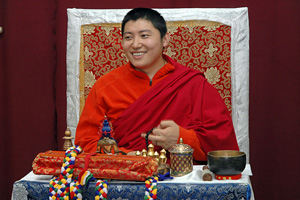
Kyabgon Phakchok Rinpoche
Synopsis of the lecture program
บทความย่อของธรรมบรรยาย
For full schedule please check
สำหรับกำหนดการและสถานที่กรุณาดูที่
https://www.mongkol.org/phakchok-rinpoche/kyabgon-phakchok-rinpoche-visit-jan-2011/
Details in English can be found below as well as at Little Bangkok Sangha www.littlebang.org
LOVING KINDNESS AND COMPASSION
Avalokiteshvara is the embodiment of compassion of all the Buddhas. In the Theravada tradition, Loving Kindness is translated as Metta and Compassion is Karuna. “Metta” is the wish for all sentient beings to be full of happiness and causes of happiness while “Karuna” is the wish for all sentient beings to be without suffering and without causes of suffering. These principles are very important in Buddhism as they are part of the 4 Immeasurables.
Avalokiteshvara is also known as Chenrezig in Tibetan or Kuan Yin in Chinese. It is spoken in the tantras and explained by Guru Rinpoche himself that just by calling his name and making a connection with him in any way, let alone by chanting the Avokiteshvara Mantra and doing the practice, all six classes of beings can be liberated from the six realms of samsara (hell, hungry ghost, animal, human, demi-god, and god realms), and all the sufferings contained therein, for example, birth, old age, sickness and death.
MEDICINE BUDDHA
The practice of Medicine Buddha, the Supreme Healer, is an extremely powerful method for healing physical illnesses, both for oneself and others, and also for overcoming the inner illnesses of attachment, hatred, and ignorance. Therefore, meditating on Medicine Buddha can help decrease physical and mental illness and suffering. The Medicine Buddha mantra is held to be extremely powerful for the healing of physical illnesses and purification of negative karma. It is said that just by hearing the mantra once, one will not be reborn in the three lower realms, so making a connection with Medicine Buddha, however small, has enormous benefits.
THE PATH TO A HAPPY MIND
The world is getting increasingly volatile with apparently more human suffering caused by increasing frequency of natural disasters or human acts of violence than other times in recent memory. The objective of this talk by Rinpoche is to teach us how as human beings, we can make ourselves and our world better through a better understanding of nature of things. Here Rinpoche will give advice from the Buddha’s teachings on how to tame our minds and negative emotions and implement the Buddha’s teachings so that we can live peacefully, happily, and harmoniously, regardless of what happens in the external world.
HOW TO DISPEL NEGATIVE EMOTIONS
There are five main classifications of negative emotions according to Buddhist teachings, anger, greed, ignorance, pride and jealousy. Rinpoche will teach us methods to recognize these emotions in ourselves and methods to dispel them. To recognize negative emotion is very important for all levels of practitioners. Reduction of negative emotions can often indicate the positive progress of the practice.
ESSENCE OF THE BODHISATTVA PATH
Before the Buddha achieved full enlightenment , he was a Bodhisattva. Bodhisattva practices are the perfection of the six paramitas, especially the paramita of wisdom, with the foundation being the Bodhicitta.
The Bodhisattva path includes the qualities to be able to actively benefit all sentient beings without any hesitation or fear. Rinpoche will explain the benefits of living the Bodhisattva path, and the essential characteristics of of a Bodhisattva.
BODHICITTA – THE PATH TO ENLIGHTENMENT
The five basic qualities of Bodhicitta are: Clarity, Calmness, Focus, Wisdom and Compassion. Bodhicitta is a perquisite to Enlightenment. Enlightenment will free us from the samara of birth, old age, sickness, death, and endless re-birth. Rinpoche will teach us what Bodhicitta is, and how to develop it gradually in our daily lives.
ENLIGHTENED BUDDHIST TEACHINGS OF THE GREAT INDIAN MASTERS
This is a collection of very previous texts from the Tengyur (the Collected Translated Treatises) composed by great, realized masters from India, such as Vimalamitra, Kamalashila, and Singhabhadra. The texts teach the view, meditation, conduct, and fruition clearly and precisely. These texts are adorned with many quotations from the Buddha’s sutras which Rinpoche will share with us. These teachings from the Great Indian Masters are very useful for the development of one’s meditation practices.
MIND TRAINING
Training and taming the mind is the essence of the Buddhadharma and is something that all Buddhist practitioners, regardless of what level they may be, should constantly practice. Important points include reasons why one should do mind training and how to go about performing it properly. This also refers to the quotes of the Buddha from the Dhammapada, where Buddha said very clearly, ‘To tame the mind, that is the Buddhadharma.’
ความเมตตาและความกรุณาในพระพุทธศาสนา
พระอวโลกิเตศวรเป็นองค์รวมแห่งความเมตตาของพระพุทธเจ้าทุกพระองค์ ความเมตตาคือความปรารถนาให้สรรพสัตว์มีความสุขและเข้าถึงเหตุแห่งสุข ความกรุณาคือความปรารถนาให้สรรพสัตว์ทั้งปวงพ้นจากทุกข์และเหตุแห่งความทุกข์ ความเมตตาและความกรุณาเป็นธรรมะหนึ่งในสี่ข้อของพรหมวิหารสี่อันได้แก่เมตตา กรุณา มุทิตา และอุเบกขา
ชาวทิเบตเรียกพระอวโลกิเตศวรว่า “เชนเรซี” ส่วนชาวจีนเรียกว่า “กวนอิม” พุทธศาสนาตันตระยานและองค์คุรุริมโปเชได้กล่าวไว้ว่า ขอเพียงแต่เอ่ยพระนามของพระอวโลกิเตศวรและระลึกถึงพระองค์ไม่ว่าจะโดยวิธีใด เพียงแต่ภาวนามนตราและปฏิบัติถึงพระองค์ เวไนยสัตว์ในหกภูมิอันได้แก่ นรกภูมิ เปรตภูมิ เดรัจฉานภูมิ มนุษยภูมิ อสุรภูมิ และเทวภูมิ ก็จะได้รับการช่วยเหลือให้พ้นจากความทุกข์ของสังสารวัฏแห่งการเกิดแก่เจ็บตาย
พระไภษัชยคุรุพุทธเจ้า
การปฏิบัติบูชาพระไภษัชยคุรุพุทธเจ้า พระพุทธเจ้าแห่งการรักษา เป็นวิธีหนึ่งที่ทรงพลังมากในการรักษาโรคภัยไข้เจ็บทั้งสำหรับตนและผู้อื่น ทั้งยังช่วยบำบัดไข้ใจต่างๆเช่น ความผูกพัน ความเกลียดและอวิชชาได้ด้วย การทำสมาธิภาวนาถึงพระองค์จะช่วยลดความทุกข์และความไม่สบายกายไม่สบายใจ มนต์ของพระองค์ก็มีอานุภาพมากสำหรับรักษาโรคภัยและชำระบาปกรรม เชื่อกันว่าแม้ฟังเสียงสวดมนต์เพียงครั้งเดียว ก็ทำให้เราไม่ไปเกิดในสามภพภูมิที่ต่ำกว่า ดังนั้น การได้ปฏิบัติบูชาถึงองค์พระไภษัชยคุรุพุทธเจ้าจึงให้อานิสงส์ใหญ่หลวง
หนทางแห่งความสุขใจ
โลกทุกวันนี้วุ่นวายมากขึ้นทุกทีด้วยความทุกข์ที่เกิดจากภัยพิบัติธรรมชาติหรือภัยคุกคามที่มนุษย์สร้างขึ้นเอง การบรรยายครั้งนี้มุ่งสอนให้เราพัฒนาตนและทำให้โลกน่าอยู่ขึ้นด้วยการทำความเข้าใจธรรมชาติของสรรพสิ่งให้ดียิ่งขึ้น ท่านริมโปเชจะบรรยายถึงธรรมะที่เกี่ยวกับการฝึกจิตและควบคุมอารมณ์ที่ไม่ปรารถนา รวมทั้งวิธีการนำคำสอนของพระพุทธองค์มาปฏิบัติเพื่อให้เราใช้ชีวิตอย่างสุขสงบมากขึ้นไม่ว่าโลกจะวุ่นวายเพียงใดก็ตาม
วิธีขจัดอารมณ์ที่ไม่ปรารถนา
พระพุทธเจ้าได้จัดอารมณ์ที่ไม่ปรารถนาไว้ห้าประการคือ ความโลภ ความโกรธ อวิชชา ความหยิ่งยะโส และความอิจฉาริษยา ริมโปเชจะบรรยายถึงวิธีการเฝ้ามองอารมณ์เหล่านี้ที่เกิดขึ้นในใจเรา และวิธีกำจัด การเฝ้ามองอารมณ์ที่ไม่น่าปรารถนาให้เป็น เป็นสิ่งที่สำคัญมากสำหรับผู้ปฏิบัติทุกระดับ เมื่อสามารถลดทอนอารมณ์เหล่านี้ลงได้ ก็แสดงว่าการปฏิบัติธรรมนั้นมีความก้าวหน้า
แก่นแท้แห่งวิถีพระโพธิสัตว์
ก่อนที่พระพุทธเจ้าจะตรัสรู้ พระองค์เสวยพระชาติเป็นพระโพธิสัตว์มาก่อน แนวการปฏิบัติแห่งพระโพธิสัตว์ก็คือจะต้องสะสมบารมีทั้งหกได้ครบสมบูรณ์ โดยเฉพาะปัญญาบารมี ซึ่งมีฐานจากโพธิจิต
วิถีแห่งพระโพธิสัตว์รวมถึงความสามารถในการแผ่อานิสงส์ช่วยเหลือสรรพสัตว์โดยไม่ลังเลหรือกลัวแม้แต่น้อย ในการบรรยายครั้งนี้ ท่านริมโปเชจะได้อธิบายถึงอานิสงส์ของการปฏิบัติในวิถีแห่งพระโพธิสัตว์ และคุณลักษณะที่สำคัญๆ ของพระโพธิสัตว์
โพธิจิต – หนทางสู่การตรัสรู้
คุณลักษณะพื้นฐานของโพธิจิตมีอยู่ห้าประการด้วยกันคือ ความกระจ่างใส ความสงบ ความแน่วแน่ ปัญญา และเมตตา โพธิจิตเป็นสิ่งที่จะนำไปสู่การตรัสรู้ ซึ่งจะช่วยให้สัตว์โลกพ้นจากการเวียนว่ายตายเกิด ท่านริมโปเชจะบรรยายว่าโพธิจิตคืออะไร เราจะพัฒนาโพธิจิตในชีวิตประจำวันของเราได้อย่างไร
ธรรมะจากมหาคุรุแห่งอินเดีย
การบรรยายนี้จะกล่าวถึงข้อธรรมะที่รวบรวมไว้ในคัมภีร์ที่สูงค่ายิ่งจากเตงจูร์หรือพระวินัยที่แต่งขึ้นโดยมหาคุรุหลายท่านของอินเดีย เช่น วิมาลามิตรา กมลาศีล และสิงหภัทรา เนื้อหาในคัมภีร์จะกล่าวถึง ทัศนะ การภาวนา การปฏิบัติ และผล อย่างแม่นตรงและกระจ่าง รวมถึงพุทธวจนะจากพระสูตรซึ่งท่านริมโปเชจะยกมาบรรยาย ธรรมะจากมหาคุรุแห่งอินเดียนี้มีประโยชน์มากในการพัฒนาการปฏิบัติภาวนา
การฝึกจิต
การฝึกจิตเป็นแก่นแท้ของพุทธธรรมและเป็นสิ่งที่ผู้ปฏิบัติทุกระดับในศาสนาพุทธควรปฏิบัติอยู่เสมอ เนื้อหาหลักของการบรรยายนี้ก็ได้แก่ ความสำคัญของการฝึกจิต และวิธีที่ถูกต้องในการฝึกจิต รวมไปถึงพุทธวจนะจากธรรมบทซึ่งกล่าวไว้ว่าชัดเจนว่า “การฝึกจิตนั่นแหละ คือพุทธธรรม”
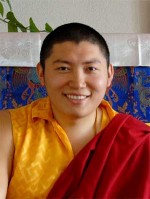 Greetings Everyone,
Greetings Everyone,
I hope you’ve all been well and happy. It’s almost midnight here in the foothills of the Himalayas and before the next day rolls in, I want to send you a little information about my whereabouts before this Guru Rinpoche day ends.
As mentioned in my last message, today is the first day of the pilgrimage and in order to mark the auspiciousness of this day, we are in Lumbini, the birthplace of Gautama Buddha. A pilgrimage is an important act of devotion and faith as it enables us to accumulate merit and purify our defilements and obscurations of the body, speech and mind by the power of the blessings of the sacred sites.
The Buddha said:
“Monks, after my passing away, if all the sons and daughters of good family and the faithful, so long as they live, go to the four holy places, they should go and remember: here at Lumbini the enlightened one was born; here at Bodhgaya he attained enlightenment; here at Sarnath he turned twelve wheels of Dharma; and here at Kushinagar he entered parinirvana. Monks, after my passing away there will be activities such as circumambulation of these places and prostration to them….. a pilgrimage to them [the four places] will help to purify their previously accumulated negative karmas, even the five heinous actions….”
Along with the four holy places we’ll be visiting other sacred sites as well and during the entire pilgrimage, I’ll think of you all and make multiple aspirations for your happiness and wellbeing.
Before I say my goodbye, I want to remind you all to constantly practice bodhicitta based on a pure motivation defined by the union of both compassion and wisdom. As mentioned by Dza Patrul Rinpoche in his Words of My Perfect Teacher, bodhicitta can be viewed as having different levels. He mentions that the highest level is that of the shepherd, who makes sure that all his sheep arrive safely ahead of him and places their welfare before him. Next is the path of the boatman, who ferries his passengers across the river and then ferries himself back. And finally the lowest is that of the way of the king who primarily thinks of his own benefit but who recognizes that his benefit depends crucially on that of his kingdom and his subjects.
Thinking of all you on this GRD and wishing you all a very merry Christmas and a very happy New Year.
Sarva Mangalam,
Phakchok Rinpoche

Kyabgon Phakchok Rinpoche visit to Bangkok in January 2011
Details in English can be found below as well as at Little Bangkok Sangha www.littlebang.org
สมเด็จพักชกริมโปเช บรรยายธรรม มกราคม 2554
For synopsis of the lecture program
บทความย่อของธรรมบรรยายกรุณาดูที่
https://www.mongkol.org/phakchok-rinpoche/kyabgon-phakchok-rinpoche-visit-jan-2011-synopsis/
เสาร์ 15 มกราคม
1330-1630 ธรรมบรรยาย เมตตาและกรุณาในพุทธศาสนา และ พิธีอภิเษกมนตรา พระอวโลกิเตศวร ณ สวนโมกข์กรุงเทพ ข้างสวนรถไฟ
แผนที่ http://littlebang.org/2010/12/31/hhpcr-sat-15th-january-bia/
อาทิตย์ 16 มกราคม
1230-1500 พิธีอภิเษกมนตรา พระไภษัชยคุรุ (พระพุทธเจ้าบรมครูแห่งยารักษาโรค) ณ วัดทรงธรรมกัลยาณี ตำบลพระประโทน จังหวัดนครปฐม
แผนที่ http://littlebang.org/2010/12/31/hhpcr-sun-16th-jan-wat-songtam-kalyani/
จันทร์ 17 มกราคม
0900-1130 ธรรมบรรยายและบูชาพระไภษัชยคุรุ ณ ม.มหิดล ศาลายา อ.พุทธมณฑล จ.นครปฐม วิทยาลัยศาสนศึกษา ห้องประชุมนานาชาติ ชั้น 2
แผนที่ http://www.crs.mahidol.ac.th/eng/contact.htm
1800-2030 ธรรมบรรยาย “หนทางสู่ความสุขใจ” ณ โรงแรมตวันนา ถ.สุรวงศ์
แผนที่ http://littlebang.org/2010/12/31/hhpcr-mon-17th-jan-tavana-hotel/
อังคาร 18 มกราคม
1800-2030 ธรรมบรรยาย “วิธีขจัดอารมณ์ที่ไม่ปรารถนา” (ภาษาอังกฤษ ไม่มีแปลไทย) ณ โรงแรมตวันนา ถ.สุรวงศ์
แผนที่ http://littlebang.org/2010/12/31/hhpcr-tue-18th-jan-english-only/
พุทธ 19 มกราคม
1000-1500 ธรรมบรรยาย “การฝึกจิต” ณ ม.ราชภัฏสวนสุนันทา ชั้น 5 อาคารศูนย์วิทยบริการ เขตดุสิต กรุงเทพฯ (ผู้เข้าร่วมต้องนำอาหารกลางวันมาเอง)
แผนที่ http://www.ssru.ac.th/app/front/home/popup_map.php
1900-2100 ธรรมบรรยาย “แก่นแท้แห่งวิถีพระโพธิสัตว์” ณ DMG อาคารอัมรินทร์พลาซ่า
แผนที่ http://littlebang.org/2010/12/31/hhpcr-wed-19th-jan/
พฤหัสบดี 20 มกราคม 1900-2100 ธรรมบรรยาย “ธรรมะจากมหาคุรุแห่งอินเดีย” (ภาษาอังกฤษ ไม่มีแปลไทย) ณ สยามสมาคม แยกอโศก
แผนที่ http://littlebang.org/2010/12/31/hhpcr-thrs-20th-jan-siam-society/
ศุกร์ 21 มกราคม
1200-1400 ธรรมบรรยาย “โพธิจิต – หนทางสู่การตรัสรู้” ณ อาคาร CP สีลม
แผนที่ http://littlebang.org/2010/12/31/hhpcr-fri-21-jan-cp-tower/
เสาร์ 22 – อาทิตย์ 23 มกราคม
ปฏิบัติสมาธิกับท่านริมโปเช เต็มสองวัน ณ ศาลาแดงเพลส ซอย ศาลาแดง หลังโรงแรมดุสิตธานี ถ.สีลม กรุงเทพฯ (ต้องค้างคืนและลงทะเบียนล่วงหน้า) ติดต่อคุณราม 0819855564 หรือ ติดต่อเราที่นี่
*ข้อมูลอาจมีการเปลี่ยนแปลง กรุณาติดตามที่ www.mongkol.org
For full information in English with maps please check:
http://littlebang.org/2010/12/30/phakchok-rinpoche-bkk-schedule/
All talks in English and Thai except specifically mentioned:
Saturday 15th Jan
1330-1630 Loving Kindness and Compassion in Buddhism with Avalokiteshvara (Chenrezig) empowerment @ Suan Mok Krungthep, next to Mo-chit BTS station
Location map: http://littlebang.org/2010/12/31/hhpcr-sat-15th-january-bia/
Sunday 16th Jan
1000-1500 Medicine Buddha empowerment @ Bhikkhuni Dhammananda’s temple – Wat Song Dhamma Kalyani in Nakorn Pathom (must bring your own lunch)
Location details and map: http://littlebang.org/2010/12/31/hhpcr-sun-16th-jan-wat-songtam-kalyani/
Monday 17th Jan
0900-1130 Medicine Buddha Dharma talk and Puja @ Mahidol University, Salaya campus, College of Religious Studies, International Conference room on 2nd floor
Location map: http://www.crs.mahidol.ac.th/eng/contact.htm
1800-2030 The Path to a Happy Mind @ Tawana Hotel
Location map: http://littlebang.org/2010/12/31/hhpcr-mon-17th-jan-tavana-hotel/
Tuesday 18th Jan
1800-2030 How to dispel negative emotions (English only) @ Tawana Hotel
Location map: http://littlebang.org/2010/12/31/hhpcr-tue-18th-jan-english-only/
Wednesday 19th Jan
1300-1500 Mind training @ Rajabhat University – Suan Sunantha Campus, 5th floor Vithayaborikarn building, Khet Dusit, Bangkok
Location map: http://www.ssru.ac.th/app/front/home/popup_map.php
1900-2100 Essence of Bodhisattva @ DMG hall, Amarin plaza
Location map: http://littlebang.org/2010/12/31/hhpcr-wed-19th-jan/
Thursday 20th Jan
1900-2100 Enlightened Buddhist teachings of the great Indian masters (English only) @ Siam society, Asok intersection
Location map: http://littlebang.org/2010/12/31/hhpcr-thrs-20th-jan-siam-society/
Friday 21st Jan
1200-1400 Bodhicitta – The Path to Enlightenment @ CP Tower, Silom road
Location map: http://littlebang.org/2010/12/31/hhpcr-fri-21-jan-cp-tower/
Saturday 22nd – Sunday 23rd Jan
Full two days Meditation retreat @ Saladang place, Soi Saladang, Silom road, behind Dusit Thani hotel. Must reserve beforehand, number of participants is limited contact Ram at 081-9855564 or contact us here
Location: Saladang place is in the Soi Saladang just behind Dusit Thani hotel at the beginning of Silom road.
 Dear All,
Dear All,
How have you all been? Happy and Healthy, I hope.
Today is again Guru Rinpoche Day, but a special one. It was during the 10th of this lunar month back in the 8th century, when Guru Rinpoche first arrived into Tibet on the invitation of King Trisong Detsen with the suggestion of the great Indian Buddhist master, Shantarakshita to subdue the local hostile negative forces and to consecrate the great monastery of Samye and to forever plant the unshakable seed of sacred Buddha dharma. He was thus known as Padmasambhava, the Lotus-Born Guru.
The 38th King or the 2nd of the Three Dharma Kings of Tibet, Trisong Detsen was indeed pivotal in introducing Buddhism to Tibet and hence a great king, yet a simple 11th century yogi states that there is simply no king like him. In a beautiful musical score titled “faith”, which a friend of mine gave me, I first heard about the above statement. In which, Sogyal Rinpoche recites the life and liberation of this extraordinary great yogi so eloquently that tears of devotion naturally outpours.
And it goes something like this: (verbatim)
Milarepa said, I am a king, yet no king like me I have such wealth Milarepa as you know was Tibet’s great saint, yogi and poet Who inspired millions of people But he spent the years in retreat in the humblest condition Wearing just a lounge cloth and eating nettles So much that his body became emaciated and became almost green
Yet he says, I am a king and yet no king like me I have such wealth I have the seven attributes that lead to enlightenment I have the eight noble path This is my wealth
My treasure house is filled with these riches I have the sky above as my castle I have the ground below as my state I am the happiest king in the world This is what Dilgo Khyentse Rinpoche use to say
Once when you have this view
All the delusory perception of samsara may rise in your mind And be like the sky When the rainbow appears in front of it You are not particularly flattered And when the clouds appear, when the dark clouds appear You are not particularly disappointed either There is a deep sense of contentment
And you chuckle from inside
As you see the façade of samsara and nirvana This view will keep you constantly amused Like a little smile bubbling away all the time Enjoy yourself, this self And you’ll be happy And I wish you that I wish you my deepest wish that you discover that for yourself This great treasure And you keep bubbling, bubbling, bubbling, bubbling and become contagious also
The lines above by Rinpoche are simple yet profound in their meaning. For those of you who need to refresh your memory on the seven attributes and the eight noble paths, here’s a brief overview:
The Seven Attributes: (Qualities)
Faith, discipline, generosity, learning, a sense of moral shame, a sense of ethical conscience to oneself, and intelligence.
The Noble Eightfold Path leading to the cessation of suffering:
Right view, intention, speech, action, livelihood, effort, mindfulness, and concentration.
Enjoy and have a wonderful day!
Sarva Mangalam,
Phakchok Rinpoche
 Dear Everyone,
Dear Everyone,
Today I thought I’d answer a question that I get asked quite frequently by students, the difference between the mind section and the wisdom section.
In the mind section, the key is noticing. It is extremely important to notice negative emotions. There is a difference between judgment and noticing. When you have judgment then your emotions arise because judgment comes with duality. When you notice the emotions don’t arise because you don’t follow the second thought, it is only recognition of a negative emotion, nothing more.
The wisdom section can be categorized into the appearance of wisdom and essential wisdom. The appearance of wisdom is free from duality, from bad and good. Don’t think that it is bad if you have a negative emotion and good when you have a positive emotion. After all whether if it’s positive or negative, it is just an emotion, which is impermanent. One must participate in pure perception. See all emotions, positive and negative with pure perception and hence neither good nor bad. Essential wisdom on the other hand involves less judgment and without engaging. Not clinging onto the emotions, not holding onto the emotions, just letting them be. If you hold onto the emotions once they arise and do not let them dissolve naturally then that is not essential wisdom. Notice them and let them be. They will dissolve on their own, naturally. This is important to understand and practice. This is the essential teaching.
Right now I am in the very south of Brazil, near Port Alegra at Khandro Ling. Today with the sangha here we auspiciously performed Guru Rinpoche’s Shower of Blessing tsok offering. During the tsok offering I thought of you all and had you all in my heart, praying for your long life, good health, and prosperity.
Sarva Mangalam,
Phakchok Rinpoche
HH. Phakchok Rinpoche will visit Bangkok to give Dharma teachings tentatively for 10 days towards end of January 2011. Please check back often for update.
สมเด็จ พักชก ริมโปเช จะมาบรรยายธรรมมในกรุงเทพฯ ประมาณปลายเดือนมกราคม 2554
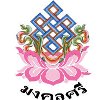



 Greetings Everyone,
Greetings Everyone,